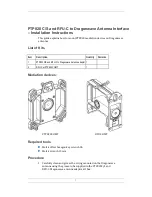
AA7B
•
5
The amplifier
On the left side of the circuit you will see J1. This is where the receiving
antenna is connected. The signal(s) picked up by the antenna are
connected to U1 pin 5 through a .01uF coupling capacitor. This capacitor is
necessary to isolate U1 from any DC levels that might be present at J1 and
allow the AC, in this case RF signals, to enter the AA7B. U1 is an electronic
relay. This device is really neat in that it performs like the old fashioned big
mechanical relays of yester-year. This relay will switch signals from DC to
over 3GHz very effectively. They are NOT a power relay capable of
controlling large amounts of power -- instead it is used for very small levels,
like the ones we are dealing with in the AA7B. You will notice that the
symbol for U1 looks like a simple Single Poll Double Throw (SPDT) switch
with a few other connections. Pins 4 and 6 are the control lines that control
the relay and also supply operating power. These two pins are connected so
that when one is in a low state the other is high. For example when pin 6 is
high pin 4 is low and the signal is connected from pin 5 to pin 1. We’ll talk
more about this later. For now we’ll assume this is the case and follow the
signal through the AA7B.
From U1 pin 1 the signal goes through C3, another coupling capacitor, to Pin
4 of Q3. Q3 is an N-Channel MOSFET Tetrode transistor. If you’re familiar
with older components, it’s just a solid state version of a tetrode vacuum
tube. Pin 4, ‘G1’, is one of the gate terminals . The small ac voltage (signal)
applied to this gate controls the large (compared to the input signal) current
that flows from the source terminal, ’S’, to drain terminal, ‘D’. As the
changing (AC) drain current flows through L1 and R7 a signal or voltage is
developed that has the same characteristics as the gate signal except
opposite phase and greater amplitude. That is how the device amplifies.
Pin 3, ‘G2’, is another gate and is between ‘G1’ and the ‘D’ to ‘S.’ By
applying a DC level to ‘G2’ the amount of ‘G1’s’ signal that is allowed to
control the output current ‘D’ to ‘S’ is changed. Think of it as the volume
control on your stereo. This control is provided by the voltage divider R2
(front panel Gain control), R3 and R4. When the user adjusts R2 so that
the arrow, called a wiper, on R2 moves toward R3 the voltage applied to ‘G2’
is increased. Increasing the voltage on ‘G2’ allows more of the signal on G1
to control the output current increasing Q3’s gain. By adjusting R2 so that
the wiper moves toward R4 the voltage on ‘G2’ decreases, decreasing the
gain of Q3. Notice that the voltage on R2’s wiper is applied to Q3 through
R5 and Q2 through R10. This allows the user to control the gain of both
amplifiers simultaneously.
C7 is another coupling capacitor which couples the amplified signal from the
drain terminal of Q3 to the ‘G1’ terminal of Q2. Looking at Q2 and the
components around it you will see that it is almost identical to the Q3 circuit.
The output signal from Q2’s drain terminal is the amplified RF signal applied




































